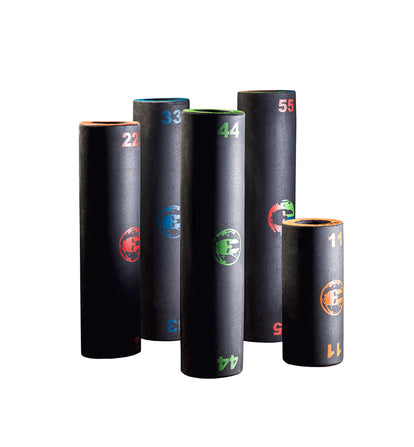This Is Why Muscle Recovery Is More Important Than Training

If you think you can’t afford to take a day off from your training schedule for muscle recovery, or that dialing down the intensity of even one workout will set you back, think again. The truth is, you can’t afford NOT to give your body a break – not if your goal is to improve your athletic performance.
“The gains you’re looking for — whether they’re speed or agility or strength or power — aren’t really made during training,” Aaron Drogoszewski, cofounder of ReCOVER and an educator for the National Academy of Sports Medicine, says. “Training is when you’re setting the stage for the potential of those gains. They only happen when you also create an environment for healing.”
So, before you decide to push through yet another grueling workout despite notable pain, physical fatigue, or even mental burnout, here's why allowing time for muscle recovery is crucial to making gains in your fitness, and how to get the most out of those moments of respite.
Why Muscle Recovery Really Matters
“People often overlook the notion that exercise is stress,” Drogoszewski says.
More specifically, it’s a kind of stress called eustress, a beneficial type that may be distressing at the moment, but provides longer-lasting physical or psychological benefits. This makes sense when you think about what exercise can do to and for your body.
“High-intensity aerobic exercise, like running or sprinting, and resistance training create little traumas or microtears in your soft tissue, specifically your muscles,” Drogoszewski says.
This can not only lead to soreness and pain, but the damage can also inhibit your muscles’ ability to replenish their stores of glycogen — the primary fuel they use for energy.
What’s more, high-intensity exercise also causes the accumulation of metabolic byproducts like lactic acid within cells.
Related: 3 Foolproof Ways to Recover Quickly During Multi-Race Weekends
“If lactic acid is pooling in your muscle belly, at the very least you might have some delayed onset muscle soreness,” Drogoszewski says.
The lactic acid buildup has also been shown to impair the electrical stimulus needed for muscle contraction, as well as the body’s ability to regenerate adenosine triphosphate (ATP), a molecule that’s essential fuel for repeated muscle contraction.
None of this stress sounds particularly beneficial until you factor in muscle recovery after training. It’s only when you create an environment for healing from exercise that those microtraumas in your muscle tissue can repair, Drogoszewski says. In the process, they adapt to handle the stress of exercise better the next time. Recovery also enables your body to efficiently clear out metabolic waste and restore the capacity to produce ATP, which essentially trains your energy systems to function at peak levels.
“When you intentionally expose yourself to something that sucks, your body adapts to that stressor, and that translates to a performance advantage,” Drogoszewski explains. “The adage ‘that which does not kill you makes you stronger’ is definitely the case with exercise.”
What Happens When You Don’t Allow for Muscle Recovery
For starters, you won’t see any of the fitness outcomes you’re looking for.
“I talk a lot about outcome over effort,” Drogoszewski says. “Consider the outcome you’re looking for — say, to win your race, or to shave 30 seconds off of your trial run. If you’re verging on overtraining, or if your system is not healing efficiently, you could be putting in all the effort, but you’re not getting the outcome because your system hasn’t healed.”
Another sign of inadequate recovery after exercise? Your sleep declines. Drogoszewski trains a lot of Ironman athletes and ultra-endurance runners who complain about being exhausted during the day, yet they’re unable to sleep at night.
“That’s one of the first signs of overtraining, and it’s because your body doesn’t differentiate exercising too much from other stress, so you go into a chronic fight-or-flight dominant state,” Drogoszewski says.
Related: Are You Training Too Hard? Here's How to Know (and What to Do About It)
The result? You’re too wired to sleep.
Cravings for sweet or salty foods are one more indication that you’re not allowing enough recovery time, Drogoszewski says. It could be due to an electrolyte imbalance caused by electrolytes lost in sweat, or it may be because your levels of cortisol and other stress-related hormones are out of whack and trigger cravings. Either way, your body is seeking faster ways to replenish fuel sources.
The list goes on from there. For instance, research in Sports Health linked overtraining and inadequate rest with impaired immune function, hormonal upset, and neurological changes that result in irritability, anxiety, and more.
7 Ways to Optimize Muscle Recovery
Your first step is recognizing the importance of recovery after exercise and prioritizing it every day.
“People should spend at least 30 minutes a day recovering, and athletes that are really pushing the envelope might want to dedicate a little more time,” Drogoszewski says.
But it doesn’t have to be consecutive. For instance, you could engage in 20 minutes of muscle recovery in the morning, and another 20 minutes later in the day.
“But you’ve got to constantly give back to your body what you took from it through all of your efforts,” he explains.
Drogoszewski also advocates for taking at least one complete day off per week, if possible, to really create an environment where your entire body can heal itself. He recommends the following techniques and technologies to help optimize your recovery whenever possible.
1. Eat Clean
Avoid the standard American diet, and opt for whole foods with good macronutrient profiles, including a lot of fiber-rich and colorful vegetables, healthy fats like avocado and coconut oil, and adequate protein. Contrary to popular belief, you don’t need copious amounts of protein for performance, Drogoszewski says.
Related: 5 Reasons That Spartans Eat Whole Food-Fueled Meal Plans
“Everything should be clean," he says. "If you avoid food in packages and shop only on the periphery of the grocery store, you’re probably in a good place.”
2. Hydrate and Replace Electrolytes
When you sweat, you lose water and a lot of electrolytes, predominantly sodium. So, in addition to drinking a decent amount of water throughout the day (about an ounce for every two pounds of body weight each day), follow Drogoszewski’s lead and start each morning with a glass of room-temperature water mixed with Himalayan sea salt to replace sodium, plus some apple cider vinegar to help regulate blood sugar and cravings. And on rigorous exercise days, consider using an electrolyte replacement tablet, such as Spartan Hydration Tablets.
3. Consider Compression
Research suggests that wearing compression garments may help increase blood flow and reduce swelling, and experts recommend them for helping increase the clearance of lactic acid and creatine kinase from the blood (a sign of post-exercise muscle damage). Drogoszewski uses NormaTec with his clients, high-tech “pants” with built-in dynamic (pulsing) compression. The compression starts at the foot and works up to the thigh to encourage circulation and push lymphatic fluid toward the trunk, where the liver and kidneys can flush out metabolic waste.
4. Practice Foam Rolling
This practice stimulates autogenic inhibition — the sudden relaxation of muscles — by applying tension to the tight spot. If you’re foam rolling before exercise, Drogoszewski says to be sure to keep moving the muscle back and forth over the roller, which brings blood to the muscles. Save applying sustained pressure for post-workout recovery, which can start to affect the neurology of the muscle and have a detrimental effect during exercise.
5. Sit in an Infrared Sauna...
Not everyone has access to an infrared sauna, but if you do, a 30-minute session one to three times per week is great for minimizing pain and loosening muscles, especially for people who are putting on crazy miles, says Drogoszewski.
“Infrared light penetrates the skin to stimulate cells’ mitochondria and expedite healing,” he explains. “It’s especially good for soft tissue, which includes ligaments and tendons that are slow to heal because they don’t get a lot of nutrients.”
Related: 6 Ways Infrared Sauna Use Optimizes Health, Training, and Recovery
Want an at-home sauna? Check out the Spartan-approved Clearlight Saunas, which Spartan CEO Joe De Sena uses as part of his weekly training routine.
6. ... Or Try Infrared Therapy
Another great recovery tool, infrared therapy boosts the production of pro- and anti-inflammatories and accelerates the healing process using infrared light, or photobiomodulation. Red and near-infrared light act as a very mild form of stress that activates protective mechanisms in the cells to promote recovery. Using a high-quality source of red light such as Joovv infrared therapy — a Spartan favorite — is the secret to gleaning the most recovery-related benefits. It even comes equipped with Recovery+ mode, which pulses NIR light to optimize the body’s natural recovery and healing processes.
7. Hit the Cold Showers or Take a Plunge
On the opposite end of heat exposure, is cold therapy. Cold-water immersion tubs like PLUNGE are becoming increasingly popular based on scientific research. The practice has been shown to improve recovery, ease aches and pains, and build mental resiliency.
Don't have a tub?
"I'm hearing the benefits derived from a two- to three-minute cold shower," Drogoszewski says.
He suggests starting with 30 seconds of cold water at the end of your shower to begin to get some benefits. Then, to take it a step further, try contrast bathing by standing in 30 seconds of hot water followed by 30 seconds of cold, and repeat.
Related: 2 Epic Reasons Why Cold-Water Therapy Is So Damn Good for You
“The warm water expands muscles, while the cold contracts them, which wrings muscles out to decrease soreness and flush out metabolic waste,” he explains.
If that feels like a lot to do, don’t let it overwhelm you.
“Do what you can, not what you can’t — a little something is better than nothing,” Drogoszewski says.
If the choice is five minutes of recovery or nothing, go with five minutes.
“Once you make muscle recovery part of your regular program, those five minutes will grow," he says. "Ultimately, it’s being consistent that yields the outcome.”



